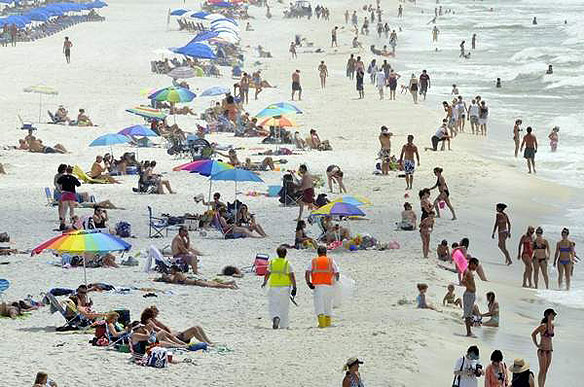
By Lloyd Dunkelberger, The Herald Tribune.
At sea, the enemy is elusive.
Aided by a strong southwesterly wind and waves averaging 4 to 6 feet, the unprecedented threat to Florida’s economy and environment lurks in the dark Gulf waters uncomfortably close to the white sandy beaches of Pensacola Beach, Navarre and Grayton Beach.
Less than 4 miles from the opening of the Pensacola Pass, the vital inlet that connects the Gulf with the inland bays, bayous and coves surrounding Pensacola, Howie Hobbs spots something in the water. It is oil.
A thin sheen, obvious to an experienced charter boat captain like Hobbs but barely discernible to others, is riding the waves. More visible are widely dispersed, reddish, coin-size globules of oil.
“It’s heading straight to the beach,” said Hobbs, a Mississippi resident who once was the captain of a BP crew ship that ferried workers and supplies to oil rigs in the Gulf of Mexico.
Pushed by the strong prevailing wind and currents, the globs of today will become the tar balls of tomorrow on the Panhandle beaches.
Starting Friday, the tar balls and patties began descending on some of Florida’s most pristine beaches.
Thus far, the impact has been minimal. On Friday, 520 tar balls were collected on Escambia County beaches — with the largest measuring a little more than 7 inches — and 12 tar mats were found floating 6 miles south of the Navarre Pier in adjoining Santa Rosa County, state environmental officials said.
The tar mats, trailing sheen, were about 30 feet by 15 feet.
The threat was met with the increased use of skimming ships off the coast and a cadre of cleanup workers along the beaches.
But the oil, which continues to spew at a rate of more than 12,000 barrels a day from the BP well, remains a growing menace right off Florida’s Panhandle shores.
On Saturday, state officials said scattered tar balls and patties were found between Pensacola Beach eastward to Grayton Beach in Walton County.
And more oil looms in the Gulf, with the state Department of Environmental Protection reporting a light sheen, 3 miles by 100 yards, a little more than a half-mile off Pensacola Beach on Saturday. State officials also noted the spill model from the National Oceanic and Atmospheric Administration placed the “primary oil plume” only 2 miles from Pensacola.









